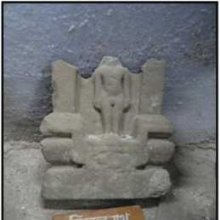Vimalanatha, Vimalanātha, Vimala-natha: 3 definitions
Introduction:
Vimalanatha means something in Jainism, Prakrit. If you want to know the exact meaning, history, etymology or English translation of this term then check out the descriptions on this page. Add your comment or reference to a book if you want to contribute to this summary article.
Images (photo gallery)
In Jainism
General definition (in Jainism)
Source: Wisdom Library: JainismVimalanātha (विमलनाथ) is another name for Vimala, the thirteenth Tīrthaṅkara (Janism recognizes 24 such teachers or Siddhas). His colour is gold (kāñcana), according to Aparājitapṛcchā (221.5-7). His height is 60 dhanuṣa (a single dhanuṣa (or, ‘bow’) equals 6 ft), thus, roughly corresponding to 110 meters. His emblem, or symbol, is a Boar.
Vimalanātha’s father is Kṛtavarmā and his mother is Śyāmā according to Śvetāmbara or Jayaśyāmā according to Digambara. It is an ancient Jain practice to worship the Tīrthaṅkara’s parents in various rites, such as the pratiṣṭhāvidhi, according to the Ācāradinakara (14th century work on Jain conduct written by Vardhamāna Sūri).
Source: archive.org: The Jaina IconographyVimalanātha (विमलनाथ) refers to the thirteenth of twenty-four Tīrthaṃkaras or Jinas, commonly depicted in Jaina iconography.—Jaina liturgical treatises attribute to Vimalanātha, the thirteenth Jina, the Lāñchana or symbol of the boar. The particular attendant spirits attached to him are named as Ṣaṇmukha and Vairoṭi (Śvetāmbara: Viditā). The King to stand for his fanner is called Svayaṃbhu-Vāsudeva. His Kevala tree is Jambu (Black-berry).
As for his parentage, his father’s name is Kṛtavarman and mother’s name is Suramyā. His birth occurred in Kāmpilya (Kāmpil in Furrukhabad), the Southern capital of the Pāñcāla. The origin of his name:—“He got his name Vimalanātha (Lord of Clearness) through the clearness (Vimalatā) of intellect with which he endowed his mother before his birth, and which she displayed in the following manner. A certain man and his wife unwisely stayed in a temple inhabited by a female demon, who, falling in love with the husband, assumed his real wife’s form. The miserable man was quite unable to tell which was his true wife, and asked the King of Kāmpilapura to distinguish between them. It was the queen, however, who solved the difficulty. She knew the long reach that witches and only witches have and telling the husband to stand a long distance off, challenged the two wives to prove their chastity by touching him. Both tried their utmost, but, of course, the human wife could not reach so far, whereas the demon wife did and thus showed her real character”.
Source: academia.edu: Tessitori Collection IVimalanātha (विमलनाथ) or Vimalanāthagīta refers to one of the twenty-four songs (gīta) embedded in the Caturviṃśatijinagīta by Jinarāja (dealing with classical hymns and stotras from Jain literature), which is included in the collection of manuscripts at the ‘Vincenzo Joppi’ library, collected by Luigi Pio Tessitori during his visit to Rajasthan between 1914 and 1919.

Jainism is an Indian religion of Dharma whose doctrine revolves around harmlessness (ahimsa) towards every living being. The two major branches (Digambara and Svetambara) of Jainism stimulate self-control (or, shramana, ‘self-reliance’) and spiritual development through a path of peace for the soul to progess to the ultimate goal.
See also (Relevant definitions)
Partial matches: Natha, Vimala.
Starts with: Vimalanathagita, Vimalanathapurana.
Full-text (+14): Shanmukha, Kritavarman, Krishnadasa, Svayambhu, Kampilya, Vidita, Jambu, Shashisaumya, Suramya, Dhanyakata, Kampilapura, Caturmukha, Mahapuri, Municandra, Samarakesarin, Anandakarin, Shyama, Vairotya, Nandanapura, Rudra.
Relevant text
Search found 5 books and stories containing Vimalanatha, Vimalanātha, Vimala-natha, Vimala-nātha; (plurals include: Vimalanathas, Vimalanāthas, nathas, nāthas). You can also click to the full overview containing English textual excerpts. Below are direct links for the most relevant articles:
Jain Remains of Ancient Bengal (by Shubha Majumder)
Images of Tīrthaṅkara Vimalanātha < [Chapter 6 - Iconographic Study of Jaina Sculptural Remains]
The twenty-four Tīrthaṅkaras and their Yakṣas and Yakṣiṇīs < [Chapter 6 - Iconographic Study of Jaina Sculptural Remains]
Meaning of Tīrthaṅkara < [Chapter 1 - Introduction and Scope of the Present Study]
Trishashti Shalaka Purusha Caritra (by Helen M. Johnson)
Invocation < [Chapter III - Vimalanāthacaritra]
Bhagavati-sutra (Viyaha-pannatti) (by K. C. Lalwani)
A study of the philosophy of Jainism (by Deepa Baruah)
Chapter I.c - The lives of the Tīrthaṅkaras < [Chapter I - Introduction]
Jainism in Odisha (Orissa) (by Ashis Ranjan Sahoo)
Iconography of Jain Gods and Goddess < [Chapter 6]
Iconography of Tirthankaras < [Chapter 6]
Iconography of Sasanadevis < [Chapter 6]
